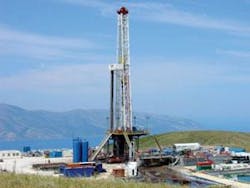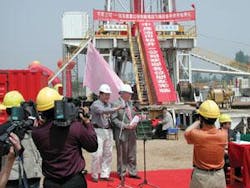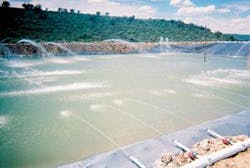5 on 5 - Five companies, each facing different financial challenges
OGFJ quizzes executives
Oil & Gas Financial Journal recently posed five key questions to five senior executives with North American E&P companies with regard to their companies’ plans for the next year or two and the challenges they expect to face.
OGFJ: What are your primary goals for this year, and are you achieving them?
Bruce Vincent: Swift Energy is focused in 2005 on increasing both production and reserves by seven to 12 percent. The keys to accomplishing our goals this year revolve around our drilling program in our southern Louisiana focus area and in New Zealand, along with the significant increase in facility capacity in our Lake Washington field that will increase production capacity by 50 percent up to 30,000 b/d of crude oil.
We are on track to meet our goals this year, and we expect production for the first half of 2005 to be up more than 10 percent compared to the first half production in 2004. Swift’s drilling program for 2005 is designed to give us plenty of opportunity to reach our goal for reserves growth of seven to 12 percent as well. The facility enhancements in Lake Washington are on track to be completed in the third quarter giving the Company the ability to continue to grow volumes in that core area even further.
Marc A. Bruner Sr.:Falcon is a unique company with a special expertise in unconventional gas. Our management team is very experienced, with a history of founding a number of prominent unconventional gas companies in the US, including Ultra Petroleum, Pennaco Energy, and Gasco Energy.
Our primary goals are to repeat and possibly extend this success in even larger areas outside North America. To achieve those goals, we have acquired a large land position in a region yet untested for the use of this technology - Central and Eastern Europe, specifically the countries of Hungary and Romania.
Our track record and business model is to first identify a large unconventional resource, second to build a large land position, and third to apply advanced drilling and completion technology. Once this is done, the project transforms into a simple resource play with tremendous upside potential.
Michael McElwrath: Far East Energy has massive holdings in China, with production sharing contracts covering over 1.3 million acres in East-Central and Southern China, and with estimated coalbed methane (CBM) resources of between 9 and 12.4 tcf (260 to 350 bcm) of recoverable CBM resources. However, that is all just “potential” until we begin to produce gas.
Our paramount goal in 2005 is to drill three underbalanced multilateral horizontal wells - two in Shanxi province and one in Yunnan - and to clearly demonstrate that gas is producible in substantial quantities by applying this technology to China’s coal seams, which are typically high in gas content but relatively low in permeability with the result being that conventional vertical wells and fracs are often disappointing.
In these types of low permeability/high gas content scenarios, underbalanced multilateral horizontal drilling (we are targeting over 4000 meters of laterals in-seam per well) can expose large amounts of coal face, thus potentially overcoming low permeability and achieving substantial gas production.
We are on track to drill these wells in ’05, with operations well underway in Shanxi.
Marc E. Bruner: Galaxy Energy’s overriding financial goal is to become cash-flow positive in the shortest possible time. To that end, we kicked off an aggressive drilling program in March 2004 on our Powder River basin (PRB) properties.
Over the next year, our most important objective is to get our PRB coalbed methane project into full production. We currently have interest in 163 completed wells and 69 wells in various stages of completion. Thirty-seven wells are currently producing gas, another 40 wells are being dewatered, and the additional wells will be brought online as quickly as our resources permit.
As we continue to drill and dewater more wells on our PRB acreage, natural gas output builds, and we will be able to reinvest our growing cash flow into this continuing development program. Successful development efforts on our Piceance basin properties will also help us achieve our goal.
We believe Galaxy Energy is on track to become cash-flow positive over the next 12 months.
Paul Laird: New Frontier Energy’s primary focus over the next year is on the development and expansion of its Slater Dome coalbed methane project located in the Sand Wash basin in northwest Colorado and southwest Wyoming. Our Slater Dome/Coal Bank Draw prospect consists of about 31,631 gross acres of oil and gas leases, which we hold a 30 percent working interest in.
We began producing gas on June 3, after completing an 18-mile gathering line to transport the gas from Slater Dome to a Questar transportation line near Baggs, Wyo. We hold a 30 percent limited partnership interest in this pipeline before payout and 25 percent after payout. New Frontier Energy and its exploration partners currently have nine gas wells at the Slater Dome prospect. Our current plans are to drill and complete three to four new wells in 2005. Our production goal is to reach two million cubic feet of gas per day over the next year which would result in about 500 mcf per day to our interest.
Next, we expect to close one significant natural gas asset acquisition where we could add existing production to build cash flow and add proven and proven undeveloped reserves to our portfolio. New Frontier, together with other working interest partners, also holds approximately 40,000 gross acres in its Nucla prospect in southwest Colorado. The prospect is generally an exploration play. Consequently, we and the other working interest owners in the play granted a two-year seismic option to an independent third party who intends to evaluate the prospect by conducting a seismic program this year.
Finally, we have an excellent exploration staff at New Frontier with a long history of developing oil and gas exploration prospects that become productive. We plan to continue to originate oil and gas exploration prospects in house. Overall, we believe the company is on track to achieve our goals.
OGFJ: In your view, what is the biggest single opportunity for your company at this time and how will you take advantage of it?
Bruce Vincent: Swift Energy has multiple opportunities to drive organic growth in 2005 and over the next several years. We have been able to create a terrific opportunity set of projects in our southern Louisiana focus area and in New Zealand, and we are well on our way to exploiting these with our drilling program. Lake Washington has been the primary growth engine for the company and will continue to deliver solid growth through the next several years driven by numerous additional drilling opportunities resulting from our recent 3-D seismic acquisition in this area.
Two additional, recently acquired fields around salt domes in southern Louisiana, Bay de Chene and Cote Blanche Island fields, have many similarities to the Lake Washington area, and we believe they may have significant potential for growth as well. While we are beginning to drill in these fields in the second half of 2005, we plan to become much more active in the next several years in this area.
Lastly, in New Zealand we have begun our Tarata thrust exploration program with a new partner, Mighty River Power Co. of New Zealand. We are focusing on deep, high potential targets in the onshore Taranaki basin. This New Zealand joint venture holds significant promise to grow reserves and production for the company as well as help meet the needs of that country’s dire natural gas crisis.
Marc A. Bruner Sr.: Clearly, Falcon’s Hungarian property is our biggest single opportunity at this time. To put this into perspective, we have assembled a land position of 576,000 acres under our two exploration licenses, which are equivalent to 900 sections, or 25 townships.
We’ve reviewed the existing geological and 2D geophysical data and have recently run our own initial 3D seismic program. This data indicates that the land is rich with targets with the potential for multiple zones per location.
We have recently contracted two rigs for an initial seven-well program, so the next step in our plan is to begin drilling, which is planned for September 2005. Two of the wells for 2005 will be shallow, which for Falcon will be about 10,000 feet. The other well will be deep, to a projected depth of 19,000 feet.
In addition to Hungary, we have acquired a coalbed methane prospect in the neighboring country of Romania. This is a logical expansion of our base of operations in Central and Eastern Europe. In Romania, we are moving in another rig to begin drilling in July 2005 [as this issue of OGFJ went to press].
Michael McElwrath: Far East is extremely fortunate to have secured a farmout from ConocoPhillips of its Shanxi province project estimated to contain 6.5 to 9.8 tcf (184 to 277 bcm) of potential recoverable coalbed methane resource, an opportunity that likely would never have presented itself were it not for the dynamics and timing of the Phillips and Conoco merger of 2002.
This project not only has the potential for very substantial gas production, but is fortunately situated with regard to the Shanghai and Beijing markets, as well as the developing municipal and industrial markets in Shanxi province. Taking advantage of this opportunity simply requires applying the right drilling and production technology and getting some iron turning to the right.
Marc E. Bruner: Galaxy has a great opportunity to parlay our outstanding technical team and project portfolio in this favorable natural gas pricing environment into one of the leading small-cap unconventional gas producers. With the gas production from our PRB program beginning to build, Galaxy plans to continue its aggressive CBM development that will take us over the next few years to the 600-plus producing CBM wells that our current PRB lease position will support.
Paul Laird: Right now the biggest single opportunity for New Frontier is to close on the gas acquisitions we are targeting. We feel this will accelerate our efforts to build the company into a solid, profitable natural gas producer. We are in discussions with several privately held gas producers, which could help us achieve this objective.
OGFJ: What are the major constraints that could prevent you from reaching your financial goals?
Bruce Vincent: Swift Energy is on pace to set records in nearly every financial category in 2005. Today, the 12-month commodity strip is comfortably above $55/bbl for crude oil and $7/Mcf for natural gas, and while we do not plan our business based on these price decks, it has certainly increased our cash flow and earnings, which are being delivered as a result of the excellent operational success to date in 2005.
The major constraints for the industry today are primarily human resources, opportunity, and industry infrastructure constraints, and these are expected to continue to be a problem in some areas. Swift Energy has prepared for these by building a large and capable staff that has worked together for a very long time and are well prepared for the future of our industry.
We have also developed a concentrated and focused set of assets with a large inventory of projects that allows us work steadily with our service and supply vendors to develop a long-term program that gives us a competitive advantage to access these services.
Marc A. Bruner Sr.: One hurdle is the availability of services. However, we have already contracted two rigs from Crosco Drilling Services of Croatia. Crosco is an international drilling company that has provided services in 23 countries. We have also secured over 182,000 feet of casing in all sizes, weights, and grades necessary to ensure that our program will proceed on schedule.
As an emerging company, capital can be a major constraint. So far this year, we have successfully raised $40 million, an amount that will carry us through 2005 and well into 2006. But the scope of this project is immense, with a resource potential in the same order of magnitude as the Green River basin in Wyoming. With the anticipated success of our Hungarian drilling program, we will require massive amounts of additional capital to develop this resource. We intend to pursue strategic partnerships along the same lines as our management team previously developed at Ultra Petroleum and Gasco Energy. To reach our objectives beyond 2005, we will also need extensions of our current exploration licenses and production licenses.
Finally, since we operate mainly in Europe, we are affected by the continuing development of the European Union (EU). Hungary became a full member of the EU in May 2004. This association brings additional economic and political stability to Hungary and improves the investment environment for Falcon. Romania has also signed a treaty for application to the EU and is expected to become a member in 2007.
Michael McElwrath: Our financial goals for 2005 are modest. Our real focus this year is to complete the first big horizontal wells, which should give strong indications of the commercial viability of our gas and thus our ultimate potential. Potential revenues will not really start to flow until 2006.
If I were to name a challenge beyond drilling, it would be the classic natural gas prospect progression - namely, moving from first production to first sales. While we may not have first sales in 2005, it will be important to advance the process of identifying potential markets and customers. Fortunately, our ConocoPhillips project in Shanxi province is almost ideally structured for marketing in that it is split into two blocks of roughly 500,000 acres (2,000 square kilometers) each with the southern (Qinnan) block located within a few kilometers of the West-East Pipeline to Shanghai, and the northern block approximately 40 kilometers from the Shanjing II pipeline to Beijing.
On top of that, Shanxi province will soon begin construction of an Intra-Provincial pipeline network with three north-south and three east-west pipelines, some already under construction.
Marc E. Bruner: As with other developing companies, a major constraint during our embryonic years has been capital. To finance our operations, Galaxy raised approximately $33 million during 2004, and we recently closed another $10 million financing.
We believe we have arranged sufficient funding to get our PRB program into production and have already completed enough wells to make the company significantly cash-flow positive once the well dewatering phase is over. A material delay in timing of production would be a constraint in that it would slow our progress.
Paul Laird: One constraint that could prevent us from reaching our financial goals in 2005 is the limited availability of drilling rigs in the Rocky Mountain region. New Frontier’s operations at Slater Dome are near the bottom of the priority list for drilling contractors since we have targeted drilling only three to four wells in 2005.
In 2006 our operations will demand more attention from drilling companies, as we anticipate being able to keep a rig busy for the entire year. We expect to have a drilling contract in place by late summer/early fall.
The second constraint facing a company of our size is the availability of capital. In today’s capital markets there is an excess of money available for public oil and gas companies. The challenge as a CEO is to insure the terms and conditions under which that capital is secured is in the best interest of the shareholders. We have an investment banking agreement with Westminster Securities, which raised $3.2 million for us in March 2005 and has committed to raise additional capital as needed.
Additionally, all CBM gas companies face environmental constraints in the production of CBM gas. One of the major constraints is the disposal of the water associated with coal gas production. We have chosen to address this issue proactively by disposing of the water associated with our coal gas wells by reinjecting the water into disposal wells. In instances where we are extending development and there is not a disposal well drilled, we are using surface evaporation pits and trucking to dispose of the water.
OGFJ: Will most of your growth this year and next be through acquisition or through the drillbit?
Bruce Vincent: Swift Energy’s current plans call for 100 percent organic growth in 2005. Our team continues to look at strategic acquisitions that make sense, but because of our quality inventory of drilling projects, we can afford to be particular when looking at acquisition opportunities. We continue to look for properties, or even corporate opportunities that would fit our operational strategy, and have considerable upside potential.
We would like to find an acquisition this year but only if it makes sense for us. We are not compelled to do one. Fortunately, we have a significant inventory of prospects and development drilling opportunities that afford us the luxury of time to complete our due diligence and to focus on acquisitions that add considerable value for the shareholders, as we have done in the past.
Marc A. Bruner Sr.: For the rest of 2005 and early 2006, we will be busy drilling in Hungary and Romania. However, a significant part of our business plan is for our new ventures team to continue to investigate and pursue other concession opportunities. If we identify the right prospect with a good fit to our exploration strategy, we would certainly consider an acquisition with production and proved reserves.
Michael McElwrath: Far East Energy plans to grow through the drillbit. If our initial underbalanced multilateral horizontal wells are successful, we will have a tremendous development project ahead of us - the proverbial tiger by the tail. While we will remain opportunistic if the right opportunity presents itself, with 1.3 million acres already tied up in China under existing production sharing contracts, we need to be highly focused on Shanxi and Yunnan.
Marc E. Bruner: Galaxy’s objective is to create value through the drillbit. We have built a portfolio of projects that exposes the company to significant reserve potential. While we are continually evaluating new projects, we are not likely to acquire properties with significant proved reserves.
Paul Laird: Growth at New Frontier Energy over the next year will be attained through a combination of drilling operations as well as targeted acquisitions.
OGFJ: How big a role will unconventional petroleum figure in your plans for the coming year? Please elaborate.
Bruce Vincent: Swift Energy has focused on the development of tight sands for many years. Both our core area in South Texas, the AWP area, and one of our core areas in New Zealand, the Rimu/Kauri area, focus on the development of tight natural gas sands through hydraulic fracturing techniques.
Our strategy will continue to focus predominately on the Gulf Coast region of the United States where there are high-quality sands with multiple horizons. We believe this is an area with tremendous hydrocarbon potential and is close to markets that realize a premium price for our product.
Swift will continue to maintain an international presence as well, which will typically consist of 20 to 35 percent of the company’s assets. New Zealand currently meets those needs for now. However, as Swift continues to grow, we see a need to have a broader presence domestically and will focus on additional areas internationally such as in other Commonwealth counties.
Marc A. Bruner Sr.: Our primary focus is on unconventional gas, mainly in the areas of tight gas, coalbed methane, and shale gas. Our management and technical team has honed its skills on unconventional gas in the USA and Canada since 1995. Now, Falcon is taking this experience and technology to other parts of the world.
Although the numbers are moving targets, it has been estimated that at least 60 percent of the undiscovered gas reserves in the US will be found in unconventional petroleum resources. We believe that this same projection will also apply outside North America.
Falcon has demonstrated its capability to source and secure investment capital. The company’s management and technical team have a proven track record, and we have acquired substantial exploration acreage.
So, in summary, when we talk about unconventional gas, we believe that Falcon has the money, the people, and the projects to succeed.
Michael McElwrath: One hundred percent of our planning is geared to “unconventional” petroleum resources in the sense that all of our efforts are directed at coalbed methane in China. As an aside, I do sometimes wonder why coalbed methane is still classified as “unconventional,” since it now accounts for 10 percent of total US gas reserves and is the fastest-growing sector of gas production in the lower 48 states.
We believe that Far East Energy is in the right place at the right time with the right commodity. China’s incredible economic growth is driving demand, and the nation’s efforts to produce more energy while at the same time seeking to improve its environment. Utilizing coalbed methane can make a major contribution to China’s efforts for the following reasons.
a) Coalbed methane represents a tremendous domestic energy resource for China estimated at 31.46 trillion cubic meters (about 1100 tcf) of gas according to China United Coalbed Methane Corp.
b) It burns substantially cleaner than coal, the current mainstay of Chinese power production and fuel supply, and
c) It actually accomplishes a net reduction in the emission of methane into the atmosphere by capturing methane that would otherwise be vented in mining operations.
Furthermore, producing CBM in advance of mining operations can save many of the 6000-plus lives that are lost each year in methane explosions in China’s mines. Add to this the fact that the bulk of China’s CBM is located in basins in relatively close proximity to its major cities and industries, and it becomes clear that CBM may well be the silver bullet in China’s quest for more energy and cleaner energy.
Marc E. Bruner: From the beginning, Galaxy’s singular focus has been to identify unconventional gas resource projects, assemble acreage, and prove up the reserves. Providing sufficient funding is in place, concurrent with our aggressive PRB development activities, we will continue to add unconventional gas prospects in the future, beginning with test wells that we have scheduled next quarter for both our CBM prospect in Romania and our fracture-enhanced tight sandstone gas prospect in Germany.
Paul Laird: The majority of New Frontier’s efforts will be focused on developing our existing CBM assets at our Slater Dome project. Additionally the acquisitions we would consider could have some unconventional reserves as well. OGFJ
Contact information:
Bruce H. Vincent [[email protected]]
Marc A. Bruner Sr. [[email protected]]
Michael R. McElwrath [[email protected]]
Marc E. Bruner [[email protected]]
Paul G. Laird [[email protected]]








